Brief History of Hat Bong Roi
According to the article “Finding the origin of Southern folk singing” by author Huynh Thanh Binh, the word “hat” in the word “hat bong roi” refers to the types of performances that include singing, music, dance, plays and stage; the word “bong” can be understood as referring to the female spirits – the people who perform the performance, or can also be understood as the shadow part of humans, helping to distinguish humans from demons (in the light, demons do not have shadows). And if the word “bong” is understood as the soul, the word “rọi” will be understood as saving, liberating the soul from evil things. The author himself also really likes this explanation because it is consistent with the nature of folk singing: in the space of the temple, people with sincere hearts turning to the gods hoping for protection will have their souls purified by the solemn, respectful singing of the female spirits.

Previously, many Northern researchers mistakenly thought that hat bong roi was a spatial shift from the North to the South of the Tam Dai Tu Phu belief because this type of art is also associated with the worship of goddesses and Mother Goddesses - a form of Shamanism. The cultural elements that make up hat bong roi originate directly from the South Central region, especially from Champa culture (this is clearly shown in the dance offering tray of the female mediums, the tray is the image of the Cham tower - the place where the gods reside).

The time of birth of Hat Bong Roi has not been determined yet, however based on the records in the two books "Gia Dinh Thanh Thong Chi" and "Dai Nam Nhat Thong Chi", this genre became popular in the 19th century.
The performance space of Hat Bong Roi is the temples in the South. This is the place of worship of goddesses, the place where deities such as Thien YA Na, Ba Chua Tien, Chua Ngoc, Ba Den, Ba Chua Xu, Cuu Thien Huyen Nu, Linh Son Thanh Mau, Thien Hau, Kim Hue, Thanh Anh La Sat, That Thanh Nuong Nuong, Co Hy, Thuong Dong, Co Hong, Co Hanh, Ba Kim, Ba Moc, Ba Thuy, Ba Hoa, Ba Tho,... However, the audience in Saigon had the opportunity to enjoy Hat Bong Roi in the space of the stage organized by Cultural Community Discourse (CCD) at Kim Ngan theater on July 13. Although this change in performance space has slightly changed the nature of the show (people come to see it not to pray for luck but to enjoy and experience), it has brought this type of performance closer to the appearance of a real theatrical art form, where the female shamans are not only "entertainers for the old lady" but also real artists.

A program of singing and dancing can last for one or more days if there are other acts, but the common format includes the following acts: Opening ceremony, Singing and inviting – inviting ancestors, Flower offering dance, Tray offering dance, Selling fortune, An vi and Performing the Dia – Nang ball play.
The pride of the female shamans in their responsibility of "entertaining the old lady"
Have you ever wondered why the people who perform the rituals, the people responsible for serving the ladies, are female mediums? Musician and researcher Le Hai Dang, in a conversation with the audience of the program “Bong Roi, Dia – Nang”, gave an interesting explanation. According to him, half-male and half-female people like female mediums in Chinese are also called yin and yang people. And according to the records of the Book of Changes, the world before separation was a chaotic realm, yin and yang were the same body, later they separated into pairs, light, clear air flew up to form the sky, turbid, heavy air flew down to form the earth. Thus, female mediums with bodies containing the two poles of yin and yang symbolize the original chaos of the universe and therefore have a connecting nature.
Although this is only Mr. Dang's personal interpretation through observation and research, it has also partly revealed to us the special status of the female mediums. Because they are responsible for serving the gods, praying for national peace and prosperity, and family blessings, they do not get married, do not have children, and spend their whole lives practicing so that their songs and dances can "please her". And they are always proud of their duty, considering it an honor.
If in the Four Palaces Hau Dong, the female mediums only perform the ritual function, and the music is performed by the musicians; the musicians are the ones who create a fantasy realm so that the female mediums can act through different realms and enter different roles, then the female mediums in the South are the artists, they use percussion instruments such as drums and clappers to accompany them while singing Chau. This is a small part of "Bai Chau Ba" (source: http://www.vienamnhac.vn/bai-viet/nhac-co/hat-bong-roi-o-thanh-pho-ho-chi-minh)
On the incense, the offerings to the palaces
The holy spirit descends and resides together
In the middle of the sky erected the Three Gates sign
Ke Linh Tieu Palace invites King Ngoa Hoang
Jade Emperor, Jade Emperor listened to the advice
Please invite Nam Tao and Bac Dau to come and have a banquet.
First Mrs. Tien Nga
Invite the second lady of the Immortal Emperor, invite the third lady of the Huong family.
Mrs. Tu Tu Dong listened to the advice.
The Five Emperors' Lady testified at this hour.
Six ladies strolling in the garden
Seven Ladies of the Upper Cave, Protecting the Golden Lotus Treasure Throne
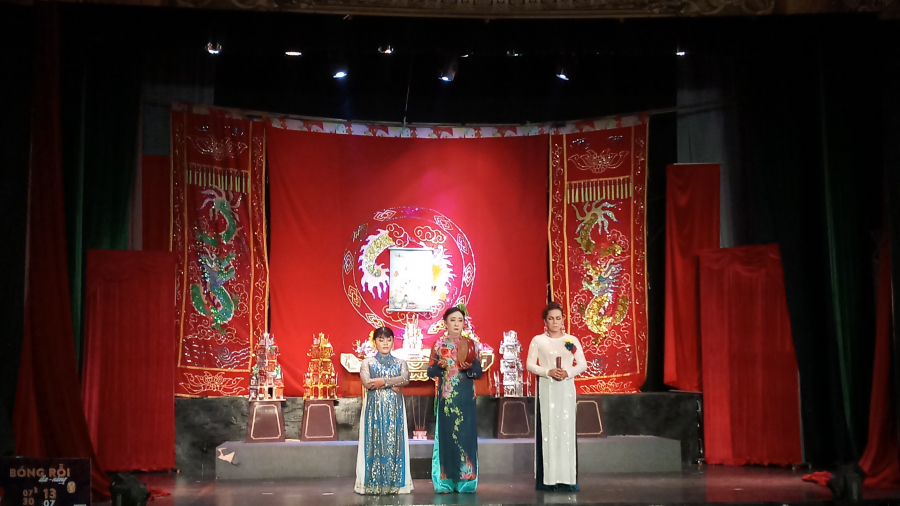
Invited singing - Invited singing in the performance "Bong Roi, Dia - Nang" (Photo: Anh Khoa)
Not only that, the dances of the shamans also require dexterity no less than that of a circus performer.
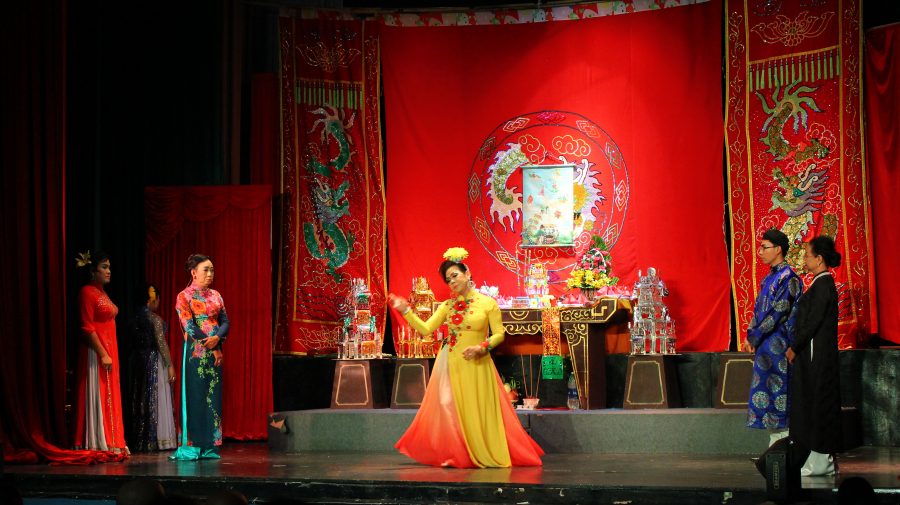
Artist Ngoc Hau performs a flower offering dance (Photo: Anh Khoa)
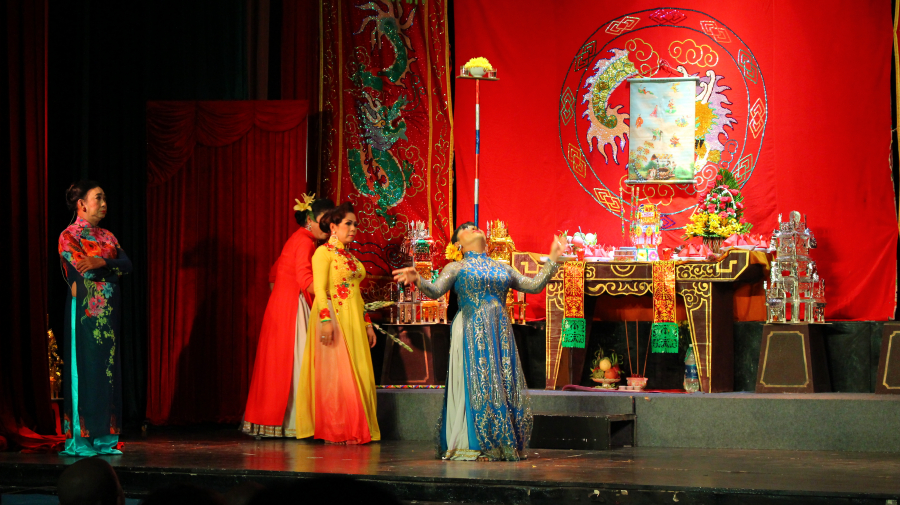
Artist Ngoc Thanh performs the Thanh Thuy Lieu Hue dance. This is a dance of water watering flowers and grass, asking for bright flowers to pray for good fortune, wealth, and family happiness (Photo: Anh Khoa)
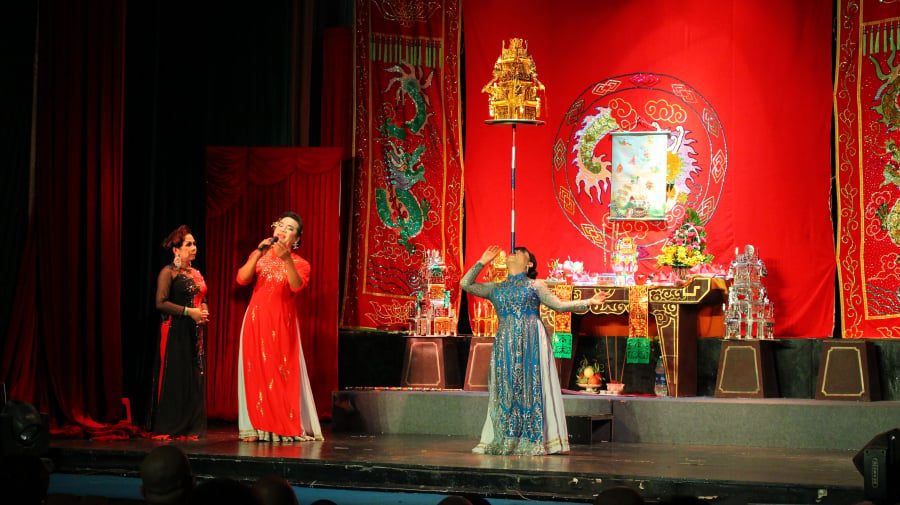
Artist Ngoc Thanh performs a dance offering the tray (Photo: Anh Khoa)
In addition, the female shamans also have the ability to dance and perform plays.
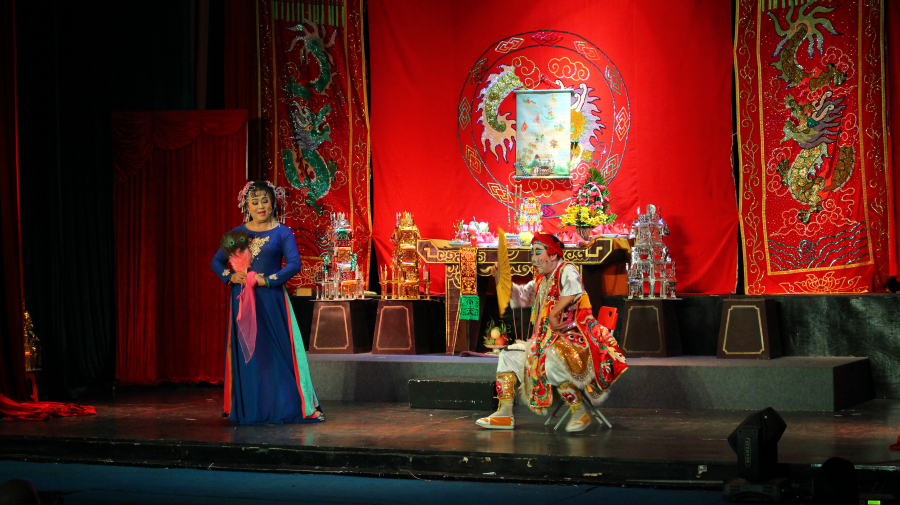
The play Dia - Nang is performed by artist Phuong Thu (as the fairy Hang Nga) and artist Minh Duc (as the god of the land) (Photo: Anh Khoa)
Singing Bong Roi – a national heritage that needs to be preserved
Hat bong roi is not only a type of folk performance with the nature of ritual practice, but its structure, presentation form and content can be completely considered an artistic performance containing unique folk cultural features. As for those who come to the temple with the wish to pray for peace, hat bong roi is like a spiritual dish that helps purify their souls in the hustle and bustle of modern life.
However, up to now, hat bong roi only exists in folk culture, meaning it is maintained by cultural practices, and the target group to maintain and deposit this art form is the female bongs without any sponsorship or encouragement from the State to help maintain and preserve this cultural heritage. Some television programs and competitions to encourage female bongs to participate but that is still not a method that has a real impact on maintaining the culture. Meanwhile, to become a real female bong, to be able to perform skillfully requires a lot of time and effort. As shared by artist Phuong Thu, who plays the role of Tien in the Dia - Nang ball show, although she was lucky to have the silent support of her mother, on the arduous path of practice, she once gave up and fell. Fortunately, thanks to her teacher, she found her love for singing bong roi again and established her own troupe with the desire to preserve and develop this unique folk art form of the nation. Hopefully, in the future, on the journey of preserving and developing singing bong roi, there will be more support and encouragement from many sources so that the female bong will no longer be a lonely place to rely on.

































